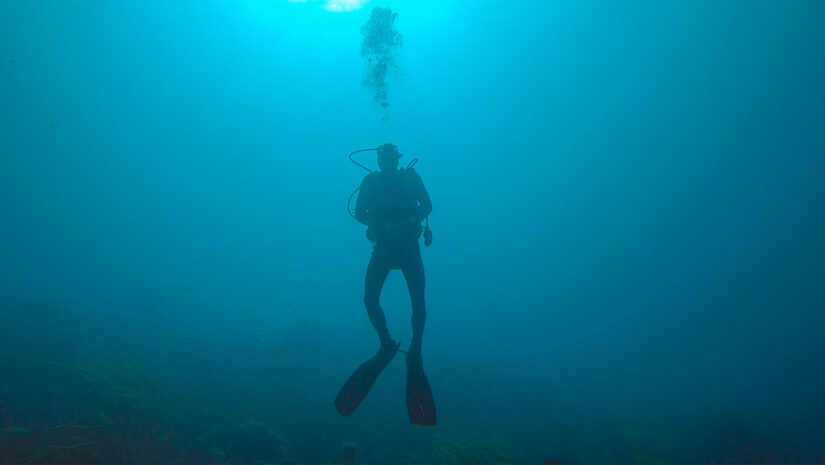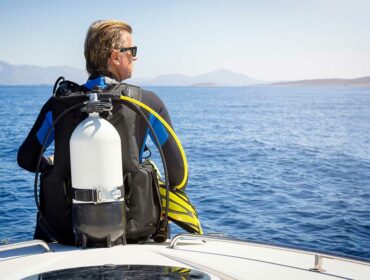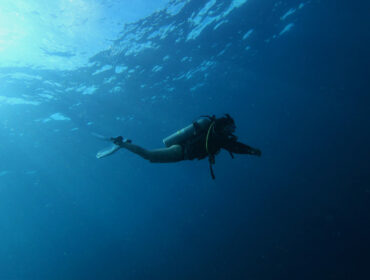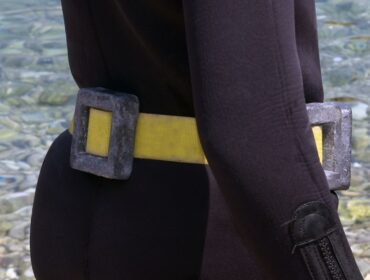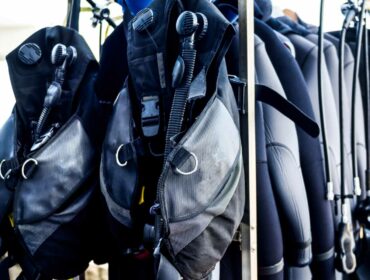A scuba buoyancy check is important for ensuring that you are properly weighted for scuba diving. You may remember this skill from your Open Water course, but probably only practiced it once. It’s good to fully understand why we do the scuba buoyancy check, and how to do it the right way.
Yes, you could just guess roughly how much weight you need and go for a dive, but this could lead to wasting air from being over-weighted, or missing your safety stop or making an uncontrolled ascent from being under-weighted.
It’s best to get your buoyancy perfect to avoid problems like these, and to make your dive feel as easy and as stress-free as possible.
Let’s look at how to do a buoyancy check like a pro.

Why is buoyancy important for scuba diving?
Good buoyancy is what makes a great scuba diver. Have you ever watched your instructor hover and move around underwater so effortlessly? This is what comes with years of experience and practice.
Good buoyancy is important for many reasons, let’s look at a few:
Protecting the reef
Most corals grow less than one inch per year, and around a quarter of all ocean species depend on reefs to thrive. This is why it’s so important not to damage corals while we scuba dive. Of course, no one would intentionally destroy corals, but accidents happen. Having good buoyancy control can help you to stay a safe distance away from the reef, and still get close enough to see it in detail.
Seeing clearly
Having bad buoyancy while diving could make you feel like you have to kick a lot to stay up and away from the ocean floor. This will kick up sand and ruin good visibility. If you feel like you are having to kick up to stay at the depth you want to be, you should add a little air to your buoyancy control device (BCD) until you no longer have to kick to stay up.
Longer dives
Having to kick up a lot will cause you to become out of breath, and therefore use up more air in your tank. Good buoyancy control can prolong your bottom time significantly.
Safety
If you are unable to control your buoyancy while scuba diving, there are some situations that could become dangerous to you. For example, making an uncontrolled ascent to the surface and increasing your risk of decompression sickness, or hitting the bottom of a boat. There’s also dangerous marine life such as fire coral, sea urchins, stone fish, etc. which can cause serious injury if accidentally touched while diving.
It’s clear that having good buoyancy is the main goal while scuba diving. Having good buoyancy comes from training and being properly weighted. This is where the buoyancy check comes in.

How to calculate how much weight you need for scuba diving
To perfect the amount of weight you need while scuba diving, you will perform the buoyancy check. But to begin, you can use your best judgement. Then you’ll have less to adjust later during the buoyancy check.
There’s a lot to consider when estimating how much weight you will need. Weight depends on whether you’re diving in saltwater or freshwater, whether you’re wearing a drysuit or a wetsuit, whether your equipment is new or old, and how much your body weighs are factors that will affect how much weight you’ll need to have perfect buoyancy while diving.
A general rule of thumb is to add around 10% extra weight to your body weight. This is a good starting point for the buoyancy check.
How to do a buoyancy check: 3 Steps
Let’s go over the three steps to perform a scuba buoyancy check:
- Now you have a rough idea of how much weight to start with, add this to your weight system. While wearing full scuba gear, enter water that is too deep in which to stand.
- With your regulator in your mouth, deflate your BCD fully, and breathe holding a normal breath. You should still be floating on the surface, at around eye level, without kicking yourself up at all. If you start to sink, you already know to take off some weight.
- Now you are floating at eye level on the surface with an empty BCD and holding a normal breath, take a full breath out. This full exhale should send you under the water. If it does not, you’ll need to add a little weight.
It may take a few tweaks but then you will know exactly how much weight is perfect for you when you’re scuba diving.
When and where to do a buoyancy check
It’s best to perform a buoyancy check at the end of a dive, when your tank is low on air (and therefore lighter than a full tank). This is because it’s important to be able to stay underwater for a safety stop and make a slow, controlled ascent at the end of a dive.
If you were to figure out your perfect weight based on carrying a full (heavier) tank of air, you might not take enough on your belt to substitute for when your tank is emptier. You can always add a little air to your BCD if you’re slightly over-weighted. But, you can’t add more weight once you’re underwater.
It’s a good idea to perform a buoyancy check every time you dive in a different lake, sea, or ocean. Some bodies of water are saltier than others and therefore the amount of weight you need will have to be adjusted, as saltwater makes you more buoyant. It’s also good to perform a buoyancy check when you change equipment. For example, a brand new 3mm wetsuit will make you more buoyant underwater than an older 3mm wetsuit.
The size and type of the tank that you are using will also affect your weighting. A steel tank, for example, weighs more than an aluminum tank. A bigger tank weighs more than a smaller tank.
The best place to perform a buoyancy check is in a calm bed of water with no current or hazards. Take your time to figure out your correct weighting for perfect buoyancy.

Different types of weight systems
While wearing scuba equipment, you will most likely float on the surface (especially if you are wearing a wetsuit). A weight system is used in scuba diving to counteract excess buoyancy and help you to get, and stay, underwater while diving.
There are two main types of weight systems in scuba diving: the weight belt and integrated weights.
Weight Belt
The most common weight belt for scuba diving is one that has lead blocks slid on. You simply thread the weight belt between the gaps in the middle of the lead weight so there’s no risk of losing them. There is a quick release buckle which opens and closes to add/take off weight, or to drop the belt in an underwater emergency.
Another type of weight belt is a belt with pockets that you put the lead blocks or lead shot pouches into. These are easier to add and remove weight, and tend to be more comfortable on the hips. They also have a quick release buckle.
Integrated weights
Integrated weights go into the BCD. The BCD has pockets built into the sides, and you add lead to pouches that can be slid in and out. The pockets are usually secured with buckles or velcro to keep them in place. Integrated weights are more comfortable than a belt, but are a little more complicated when it comes to adding or removing weight underwater. You also can’t spread the weight out around your body so much like you can with a belt.
It’s nice to experiment with different weight systems and find which is most comfortable for you. The weight system plays a big part in buoyancy control so it’s an important piece of dive gear.
Skills to perfect buoyancy underwater
Getting your weighting correct is just one part of perfecting your buoyancy underwater. You also have to master controlling your breath and your BCD.
There are skills that you learn in the Open Water course that help you to practice controlling your buoyancy. It’s important to take these skills with you beyond the beginner course, and to keep practicing them.
Let’s look at the two main skills that you practice in shallow water to learn how to control buoyancy.
Hovering
The first skill is learning how to hover, the aim for this skill is to adjust the air in your BCD and maintain neutral buoyancy while holding a normal breath. This means you are not shooting up to the surface, and you are not touching the floor. You are hovering in the middle of the water. This can be tricky at first but you quickly learn how adjusting the amount of air in the BCD just a little bit at a time, and breathing normally, can keep hovering neutrally without much up and down movement, if any.
Neutral buoyancy
The next skill is practicing using your breath to control your buoyancy. You should start with enough air in your BCD to keep you neutrally buoyant. Then you take bigger breaths slowly in and out to make you move up and down in the water. It can be hard as there is a slight delay, so you have to play around with when to start the inhale. You’ll have to test when to start the exhale before you get too close to the surface or to the bottom.
Scuba buoyancy check: What else you need to know
You can practice buoyancy control on fun dives, for example when coming up to a coral bombie that you’d like to go over the top of, you can add a little air to your BCD if necessary, or simply take a deep breath in until you start to rise over the top. The breath is usually enough to lift you up, and then you can return to regular breathing.
You will practice buoyancy control every time you descend for a dive. You will release all or most of the air from your BCD, and breathe out fully to get yourself down under the water. As the weight of the water above you gets heavier, you will start to descend quicker. To slow the descent down, you should add a little air to the BCD until you reach your desired depth. Then, make sure you are neutrally buoyant while breathing normally before continuing the dive. If you are having to kick up to stay at the depth, you should add more air.
There is further education to perfect buoyancy. For example, in the Advanced Open Water course you can choose Peak Performance Buoyancy as one of your adventure dives. This is a great choice as buoyancy is so important. This adventure dive will teach you extra buoyancy skills, and the instructor will play fun games with you. For example, you may pass weight back and forth, or try to do an underwater backflip. If this dive piques your interest, you can also go on to do the Peak Performance Buoyancy speciality. Here, you will go into even more detail about buoyancy control, and practice more skills.
Now you know everything you need to perform the perfect buoyancy check, and understand why doing one is so important.
Written by: Charlotte Stringer

